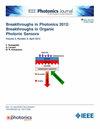金属纳米管阵列助力远红外热发射器性能提升
IF 2.1
4区 工程技术
Q3 ENGINEERING, ELECTRICAL & ELECTRONIC
引用次数: 0
摘要
我们制造并演示了一种热辐射远红外光源,它具有更高的热辐射效率,尤其是在对各种应用至关重要的 8-14 μm 波长范围内。该装置利用不锈钢材料通过溅射沉积在硅晶片上精心制作的金属纳米管阵列(MeNTA)。利用有限差分时域(FDTD)方法进行的模拟显示,黑体辐射远红外光谱发生了显著变化。通过傅立叶变换红外(FTIR)测量进行的实验验证证实了明显的波长过滤效应,主要集中在 10.2 μm。采用不锈钢 MeNTA 的装置发光效率提高了 1.4 倍,达到 7.45 × 10-3,辐射功率为 11.034 mW,单位面积辐射功率为 0.681 mW/mm2。这些结果表明,利用其他几何形状和时期扩展制造工艺以定制特定红外辐射的潜力巨大,从而使热发射器适用于生物医学应用。本文章由计算机程序翻译,如有差异,请以英文原文为准。
Metallic Nanotube Array Enabling Far Infrared Thermal Emitter Performance Enhancement
We fabricate and demonstrate a thermal-radiation far-infared light source with enhanced thermal radiation efficiency, particularly within the crucial 8--14 μm wavelength range, which is vital for various applications. The device utilizes a metallic nanotube array (MeNTA) meticulously fabricated on a silicon wafer using stainless-steel material through sputter deposition. The simulation with Finite-Difference Time-Domain (FDTD) approach reveals significant alterations to the blackbodyradiated far-infrared spectrum. Experimental validation via Fourier Transform Infrared (FTIR) measurements confirms a pronounced wavelength filtering effect, primarily centered at 10.2 μm. The device incorporating stainless steel MeNTA exhibits 1.4 times improvement in luminous efficiency, reaching 7.45 × 10
−3
, accompanied by a radiated power of 11.034 mW and 0.681 mW/mm
2
radiated power per area. These outcomes suggest the potential for expanding the fabrication process with alternative geometries and periods to tailor specific infrared emissions, which enables suitable thermal emitters for biomedical applications.
求助全文
通过发布文献求助,成功后即可免费获取论文全文。
去求助
来源期刊

IEEE Photonics Journal
ENGINEERING, ELECTRICAL & ELECTRONIC-OPTICS
CiteScore
4.50
自引率
8.30%
发文量
489
审稿时长
1.4 months
期刊介绍:
Breakthroughs in the generation of light and in its control and utilization have given rise to the field of Photonics, a rapidly expanding area of science and technology with major technological and economic impact. Photonics integrates quantum electronics and optics to accelerate progress in the generation of novel photon sources and in their utilization in emerging applications at the micro and nano scales spanning from the far-infrared/THz to the x-ray region of the electromagnetic spectrum. IEEE Photonics Journal is an online-only journal dedicated to the rapid disclosure of top-quality peer-reviewed research at the forefront of all areas of photonics. Contributions addressing issues ranging from fundamental understanding to emerging technologies and applications are within the scope of the Journal. The Journal includes topics in: Photon sources from far infrared to X-rays, Photonics materials and engineered photonic structures, Integrated optics and optoelectronic, Ultrafast, attosecond, high field and short wavelength photonics, Biophotonics, including DNA photonics, Nanophotonics, Magnetophotonics, Fundamentals of light propagation and interaction; nonlinear effects, Optical data storage, Fiber optics and optical communications devices, systems, and technologies, Micro Opto Electro Mechanical Systems (MOEMS), Microwave photonics, Optical Sensors.
 求助内容:
求助内容: 应助结果提醒方式:
应助结果提醒方式:


